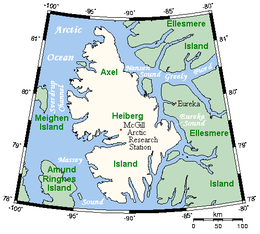McGill Arctic Research Station
| McGill Arctic Research Station | |
|---|---|
| Research Station | |
| Country | Canada |
| Territory | Nunavut |
| Region | Qikiqtaaluk Region |
| Population | 0 |
| Time zone | North American Central Time Zone (UTC-6) |
| • Summer (DST) | CDT (UTC-5) |

McGill Arctic Research Station
McGill Arctic Research Station (Expedition Fiord) is a small research station operated by McGill University located near the centre of Axel Heiberg Island. Its coordinates are 79°20'09.1"N 91°58'45.0"W. It was first established in 1959 after scientists explored South Fiord (Expedition Fiord). The station contains a small hut, a cook house and 2 temporary structures. It can support 8-12 people and gives them access to the research activities. The current activities are glaciology, climate change, permafrost, hydrology, geology, geomorphology, limnology, planetary analogues, and microbiology.[1] Today, the station is only used in the summer months so there would be enough power generated from the solar panels.[2]
The director of the research station is Wayne Pollard (from McGill University). He has many experiences with drilling and geophysical tools. His goals are to identify niche environments in permafrost capable of harboring microbial life at or near the limit of its habitability.[3]
Geography
McGill Arctic Research Station is located near the terminus of 3 glaciers: Baby Glacier, White Glacier and Thompson Glacier. It is also beside the Expedition River and Colour Lake. The glaciers have been monitored from 1960 to 1999 with gaps in between them. The closest community is Grise Fiord, 500 km away. However, all flights to and from the station all go to Resolute Bay, Nunavut. The area surrounding it are rolling hills and tall mountains.
Climate
The average temperature at the Research Station is -15 degrees Celsius. Because of the cold temperatures, they can test how microbes can survive on the other colder planets in our Solar System.[4] The station receives polar night from the first week of November until the beginning of February, and the midnight sun from the beginning of April until the second week of September.[5]
See also
- Baffin, Unorganized - the census area to which McGill Arctic Research Station belongs
- Eureka, Nunavut - another research station close to McGill Arctic Research Station
- Axel Heiberg Island - the island the research station is on
Notes
- ↑ McGill Arctic Research Station|McGill Arctic Research Station (M.A.R.S.). Dale T. Anderson, Centre for the study of life in the universe. Retrieved April 11, 2015
- ↑ Gonçalves, Mário. "Axel Heiberg". Ultima Thule. Retrieved 13 April 2015.
- ↑ White, Lyle. "Wayne Pollard". NSERC CREATE Canadian Astrobiology Training Program. Retrieved 13 April 2015.
- ↑ Scientists detect cold-loving microbe in Nunavut’s High Arctic|Can life exist on other colder planets? Nunatsiaq Online. Retrieved April 12, 2015
- ↑ Advanced options and sun angles| Sunrise/Sunset/Sun Angle Calculator. National Research Council Canada. Retrieved April 12, 2015
External links
| Wikimedia Commons has media related to McGill Arctic Research Station. |
- Canada's North may hold clues to water (and life!) on Mars
- Ice Related Data Series from Expedition Fiord
- Monthly Archives: August 2010 MARS